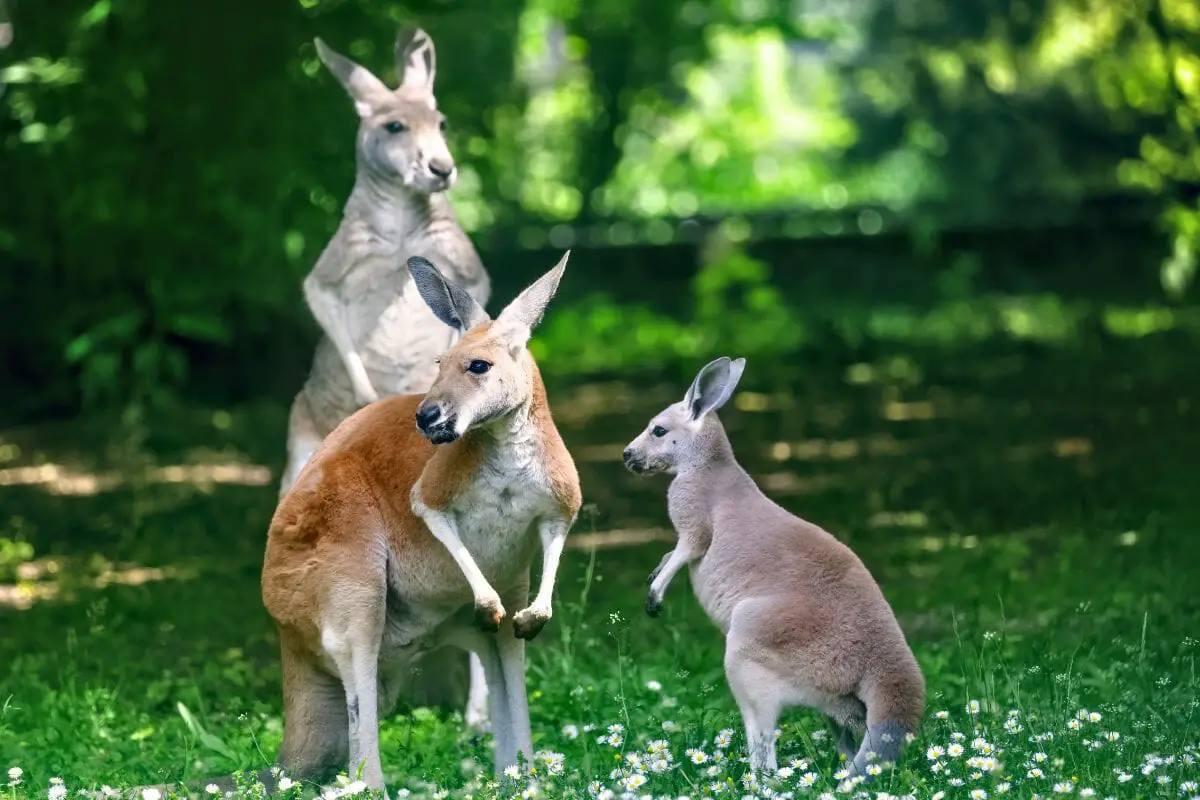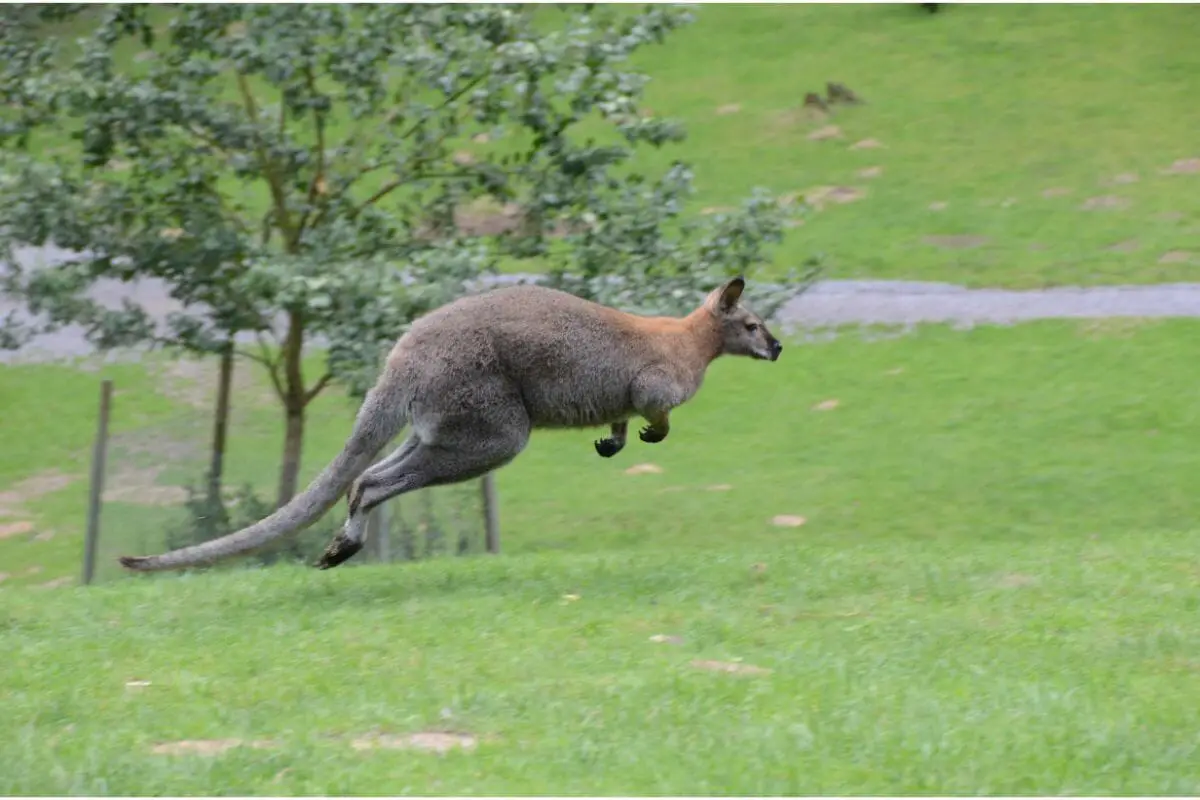Kangaroos are an animal like no other. With their distinctive pouch and hopping movements, they stand out in the wildlife crowd.

Think of Australia and one of the first things you will imagine (apart from spiders) is a kangaroo. But, have you ever wondered how these animals came to be like they are today?
After all, having a pouch to keep your babies warm for the first few months of their lives isn’t very common in nature. Well, apart from 335 species of the infra class of marsupials.
The kangaroo’s story started some 30 million years ago in, you guessed it, an Australian rainforest.
A small animal, much like a possum, decided to climb down from a tree and started to live life on the ground below. And thus started the evolution of kangaroos and many other incredible animals.
Want to find out more about how kangaroos evolved? You’re in the right place! Read on as we delve into the history of this fascinating marsupial, indigenous to Australia and New Guinea.
Kangaroo Evolution
Around 30 million years ago, a marsupial-like creature crawled out of the trees for the first time and started to roam the land below. Hence, the Australia Kangaroo was born. This was the very beginning of the evolution of kangaroos and countless other amazing creatures.
One of these animals was a giant (see also: Animals That Used To Be Giant) kangaroo known as Procoptodon Goliah, a large leaf-eating marsupial. How large?
It is believed that this kangaroo weighed hundreds of kilograms, and rather than walk like the kangaroos of today, experts believe it walked more like a dinosaur.
The Procoptodon Goliah is thought to have gone extinct about 15,000 years ago but its legacy remains.
Today, we are all more familiar with the iconic red kangaroo. Bounding across the Australian outback, these can also be domineering and large, with the male kangaroo weighing up to 92 kilograms.
So big that the red kangaroo is the world’s largest marsupial on Earth today. It might be large by todays standards but seeing some of its predecessors it could certainly be classified as a small kangaroo (Also check out Are Kangaroos Rodents).
In some Queensland rainforests, you will find a tiny kangaroo, known as a musky-rat kangaroo. This is on the other side of the marsupial scale, weighing not much more than just half a kilogram.
This species, though, is regarded as a “living fossil” as it has been on Earth for millions of years. In fact, many believe it is the earliest example of a kangaroo.
The Earliest Ancestor
The earliest known ancestor of the kangaroo is thought to have looked like a small musky rat-kangaroo. This marsupial-like creature actually evolved in Australia but not as we know the country as it is today.
Then, Australia was covered in rainforest and this tree clambering kangaroo-like animal called the trees its home.
This early ancestor belonged to an ancient group of animals that never grew very big. Most grew no more than 3 kilograms, with species such as Potoroos and Bettongs being part of the family.
These animals lived (see also: What Animals Live In Arizona?) in dense rainforest, and fed on fruit, fungi, and insects, rather than grass like the kangaroos of today.
Modern day musky-rat kangaroos curl their tails, which is believed to be inherited from their ancestors who clung onto trees.
Although the musky-rat kangaroo is an ancient kind of kangaroo, tree kangaroos are more recent in terms of their evolutionary history.
Instead, these evolved from hopping, ground-based kangaroos. You could say they decided to return to the trees where their ancestors once inhabited.
The reason behind an animal’s evolution is typically down to climate change and the need to adapt to changing conditions. The same applies to ancient kangaroos.
Over tens of millions of years, the climate altered. Therefore, rainforests started to disappear with drier sclerophyll forests taking over.
As this continued, the large Procoptodon developed and started to live on the tougher stems and leaves of these new trees. This species, along with many others, decided to remain in these forests.
But, some species wanted to explore.
Red and gray kangaroos began venturing out into the open plains and ever growing grasslands. Because of this migration, these kangaroos outlived their giant cousins, such as the Procoptodon.
This successful migration was a key step in the evolution of kangaroos. It is believed that red and gray kangaroos excelled and survived because of their teeth’s evolution.
They developed teeth with higher crowns, allowing them to chew on tough, harsh grass.
Kangaroos boast a large set of molar teeth that allows them to chew almost constantly.
What Happened To The Kangaroo’s Ancestors?
Nature and wildlife of ancient times was very different to today’s. For a period of time, giant animals roamed the Earth, with some weighing over a tonne!
These large animals are referred to as Megafauna, with giant kangaroo ancestors, such as the Procoptodon being one of many.
Today, many consider the kangaroo to be the last of the megafauna. But, how come red and gray kangaroos survived but many of their ancestors did not?
Debate rages on about what actually ended the reign of megafauna animals, like the Procoptodon, in Australia. Nevertheless, many believe these animals became extinct because of climate change and over-hunting.
A Procoptodon would have moved at a much slower rate than other smaller kangaroos. Therefore, it was easier to hunt them. And, with the amount of meat they possessed, they probably became a main target of hunters.
Also, because these beasts were so large, they may have simply run out of the vast amount of food they needed to survive.
There’s also the fact that large animals like the Procoptodon would have bred slowly, meaning their numbers may have started to dwindle rapidly.
Maybe if they hopped, things would have been different. Let’s find out why kangaroos hop in their comedic way.
Evolution Of The Kangaroo’s Hop

As you have probably seen, kangaroos hop on their two hind legs. However, the fact kangaroos do this is quite peculiar, as most animals that hop are much smaller.
There’s no doubt about it though; hopping is an extremely efficient and fast way to get around. Kangaroos have been known to reach speeds of 64 kilometers per hour. That’s fast!
The reason kangaroos can hop so well is thanks to their large feet and overly large shin bones. Why kangaroos evolved in this way is still a mystery to experts.
However, it is theorized that kangaroos developed this ability and bone structure to manage the different activities they needed to do in the ever-changing landscape.
As well as climbing trees, kangaroos had to start running and rummaging for food on the ground. Because they needed to dig for some food, the back legs evolved especially for certain movements, whilst the forelimbs evolved for climbing and digging.
If you want to know what the peak of hopping evolution is, just watch a red or gray kangaroo in action. It allows them to survive in different landscapes, whether they be forest floors, dry, parched land, or grasslands.
Although kangaroos can hop better than any animal, their legs are not that good at moving independently of one another. Therefore, they have evolved further and developed a certain “locomotion” known as pentapedal walking.
This involves the kangaroo making a sort of tripod, using their tail and hands. Therefore, their legs can then move at the same time.
You may have seen a kangaroo placing its hands on the ground with their tail under their hind legs. This allows them to put their body weight on their tail and arms, so their legs move at the same time.
With such a movement, it’s no wonder many kangaroos have such muscular upper body frames
In Summary
Kangaroos are either loved or loathed by people, especially in Australia.
But, whether you consider them fascinating creatures or vermin, there’s no doubt that they are one of the most adaptable species on the planet and their evolution is one to be in awe of.
- What Should I Do If A Koala Bites Me? Safety Guide - 2024-05-30
- Are Kangaroos Born Without Hind Legs? A Fascinating Journey - 2024-05-30
- Animals That Look Like Squirrels - 2024-05-30









